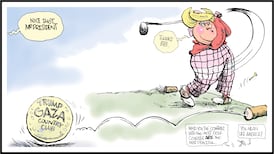Does anyone play conkers any more? Each autumn I walk under a magnificent tree at UCD which yields hundreds of chestnuts. Thirty years ago, I'd have to be in early in the morning to collect any windfalls, for local boys left nothing to chance. But now the harvest lies on the ground, forlorn and unclaimed.
In my childhood, conkers marked the moment when autumn had truly come. The nuts, when prised out of their prickly green skins, smelt so fresh that they seemed to have come newly minted out of Eden.
If you polished them with a handkerchief (a rare but useful boy's accessory in the old days), they shone like mahogany, but new conkers were soft and easily shattered.
That softness was useful, for it made it easy to hammer a nail through the nut, so that it could be held on a piece of strong string, with a firm knot tied at the end.
Some boys strung dozens of conkers on long strings and marched around the parish wearing them over the shoulder, bandolier-style.
Than the fun began. One boy challenged another, heaping witty disparagement on "that shrivelled thing" or "your puny nut". (I know, I know - Dr Freud would have had much to say of this.)
Conkers was essentially a spectator sport. It copied the protocols of prizefighting. Large numbers of boys formed a noisy ring around the contestants. The boy challenged had the "honour" of opening hostilities.
Often, his very first shot smashed the opposing nut into smithereens. If, after many shots, nothing much was happening, a contestant might call for the ring to be widened, so that he could take a running shot at full speed.
Sometimes, the running boy's conker would completely miss the target, hitting his rival a painful bow on knuckle, arm or even head. Or the two strings would become hopelessly tangled.
If your conker had beaten four new ones, you were "conker four", but if your "four" defeated an "eight" , you instantly became "conker 12".
Canny souls would pick and choose opponents, weighing up prospects: but repeated refusals led to cries of "cowardy cowardy custard/stick your head in mustard!"
Urban legends abounded. A conker from a neighbouring parish was rumoured to be "81". Boys roamed the streets collecting information and reports. Although some of the numbers claimed seemed frankly incredible (for conkers were weakened by each blow sustained), everyone at first chose to believe them.
With games watched so closely, it was hard for people to lie.
Many arcane methods were used to harden nuts, from soaking them in your mother's vinegar bottle to greasing them with the linseed oil used on cricket bats or roasting them in the ovens or secreting them in the chimney. Some intrepid souls kept nuts from the previous year and these tended to be darker and harder, but smaller too.
At the outset of every autumn, boys desperate for the season to begin would climb huge trees to shake the chestnuts down, or they would fire sticks at the lower-hanging ones.
Nature, which every year provided this wonderful game free of charge, often needed a little prompt to act on cue.
By season's end, we would all have grown bored with the sport, and weary of grandiose claims for "conker 601".
The lure of chestnuts would fade and entire handfuls were swapped for a couple of marbles or a single football card.
Did girls every play conkers? I'm sure that in private many did: but in public they had their games of skipping and wall-ball which were off-limits to boys.
Everyone, boys and girls alike, built tree- houses, but only boys made bows-and-arrows out of the springy branches.
How many kids play such games now? Or has the fear of injury (voiced by anxious parents) and of litigation (on the part of teachers) put an end to it all? Not to mention the flashier attractions of Grand Theft Auto and surfing the net.
Perhaps there are still boys and girls who subscribe to conkers like devotees of an underground movement - but, if there are, they are probably very young, innocent sorts who will soon be educated out of such foolishness by their older siblings.
The lore of schoolchildren keeps changing, but trees no longer seem to form a major part of it.
Yet once there were wishing trees, sacred trees, unlucky trees. They are all still there, with vast roots in the ground, like images of our own unconscious.
But nowadays, fewer and fewer people seem to see them or use them.
As the parodist wrote: "I think that I shall never see/A poem lovely as a tree./In fact, unless the billboards fall,/I'll never see a tree at all".








